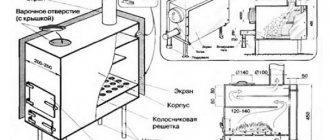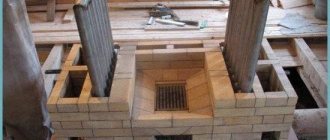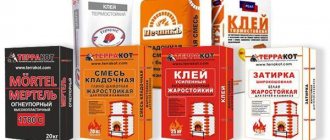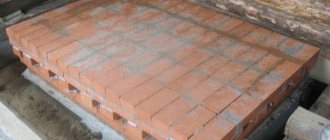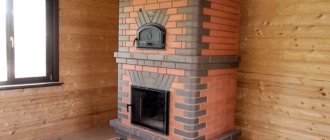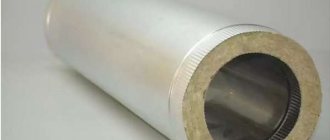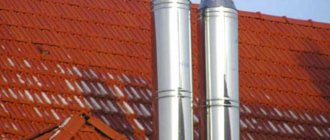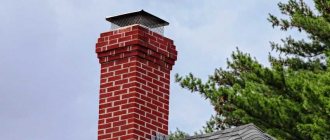Owners of apartments or houses with gas heating will not be interested in the topic of this article, but those who use any solid fuel for heating are well aware that sooner or later, soot accumulates in the chimney, and what consequences this can entail. In this article we will talk about the causes and how to remove soot from the chimney.
Reasons for its appearance and what it means
The reasons for the formation of soot in the chimney can be very different, and often this is a consequence of improper operation of the stove device. Let's list the most common causes:
- Using raw firewood or fuel briquettes.
- Incorrect chimney configuration, preventing the normal passage of smoke.
- A large number of irregularities on the inside of the pipe.
- Pollution and littering of the chimney during the time when it is not in use.
- Burning various household waste and especially plastic in a furnace.
- Frequent change of wood species burned in the firebox.
In fact, these are not all the causes of soot, but they are the most common.
Advice! To fire a stove or fireplace, you need to use only well-dried firewood, aged for at least one and a half years.
The chimney pipe gets hot and turns red
The reason for the red glow of the metal is heating above 550 degrees. This is 100-150 degrees higher than the permissible operating temperature of heat-resistant steel. When using cheaper alloys, overheating occurs even earlier. The culprit is too much draft in the chimney. Excess thermal energy released during the combustion of wood overheats the metal and, instead of heating the interior, literally flies out into the chimney, creating a real fire hazard.
Consequences of soot accumulation
Often, homeowners neglect cleaning the chimney, and in vain, since in addition to the basic deterioration of draft, this can lead to a number of sad consequences, some of which can not only cause harm to health, but can also lead to death.
We are now talking about the absence of draft and penetration of carbon monoxide into the room. Its danger lies in the fact that, unlike smoke, which has a characteristic odor, carbon monoxide has no odor at all, but at the same time it is deadly to health and life. But that’s not all, here are just a few possible scenarios for the development of events with a clogged chimney.
- The soot that accumulates in the chimney can sooner or later flare up and with poor brickwork, high temperatures can lead to a fire in the roof, as shown in the photo above.
- The narrower the chimney passage, the more sparks escape from the tip. In strong winds, both the roof itself and the surrounding buildings may catch fire.
- ignition of soot in the chimney can lead to strong backdraft, as a result of which the fire will go inside the room and it will be very difficult to stop it.
- A thick layer of soot will accelerate the wear of the brickwork.
- Carbon deposits prevent uniform heating of the fireplace and chimney, resulting in a significant reduction in the efficiency of the device.
These and many other factors sooner or later make every homeowner wonder how to deal with soot in the chimney, and this is what will be discussed below.
Important to remember! Experts advise carrying out preventive cleaning of the chimney at least twice a year; this will not only extend the life of the stove or fireplace, but will also allow you to clean it yourself quickly and without much difficulty.
What is the risk of plaque accumulation:
- the draft and efficiency of the stove (fireplace) decreases;
- the internal walls of the chimney are destroyed;
- A malfunction of the chimney can cause a fire and carbon monoxide poisoning.
The last circumstance is extremely important. Due to the high combustion temperature of soot, the chimney can collapse; any spark from the same fireplace can ignite deposits on the walls of the chimney and lead to a fire.
Soot can be of different fractions, greasy, loose or resinous - the last type poses the greatest fire hazard.
The temperature when soot burns reaches 1200 degrees, and although the fire does not burn for long, this phenomenon often has the most dire consequences.
In addition, when the chimney heats up, it can destroy adjacent roof elements.
Plaque will form in any case, but its amount can be minimized by following simple rules.
Chimney cleaning
Today, with the growing popularity of fireplaces in private homes, the profession of a chimney sweep is becoming increasingly in demand. Of course, the price for their work is often very high, so many people decide to clean the chimney themselves.
Below we will provide detailed instructions and describe several methods, the choice of which depends on personal capabilities and the degree of contamination of the chimney. For example, traditional methods or chemical cleaning methods are most often possible only at the very beginning of the build-up of soot, but if a lot of soot has accumulated, then you will have to resort to mechanical cleaning, and this is the most complex and time-consuming method, but first things first.
Traditional methods
Most traditional methods are based on burning soot in the chimney, and therefore, it is necessary to increase the combustion temperature to such an extent that the soot ignites without starting a fire in the ceilings. That is why, before using one of the listed methods, you need to make sure the quality of the pipe laying.
- Rock salt. One of the most popular methods by which soot is burned out of a chimney. Salt is poured onto the burning wood and the firebox is closed. The temperature in the vent will rise and the soot will flare up, while some of it will burn without a trace, and some will fall down.
- Potato peelings . At first glance, the method may seem strange, but in fact, everything is simple - the starch in potatoes softens the hard soot and it ignites. The main difficulty of this method is that it is very difficult to calculate the required number of cleanings, but on average they take one full bucket per ignition, after which they check the condition of the chimney and, if necessary, repeat the procedure.
- Aspen logs . The fact is that this tree has the highest combustion temperature, so if you fill the firebox with aspen logs, soot will burn out from the chimneys, but this must be done very carefully, since the temperature in the solid fuel stove and chimney will be very high.
- Turpentine . Another method was very popular in the past; firewood is generously watered and set on fire, which creates intense heat, which removes soot from chimneys.
- PHC. A domestic product produced in the form of a powder, packaged in 50 gram bags. The contents of one package must be poured onto the firewood and lit. The active substances in the product will react with carbon deposits and decompose it into its constituent components, which will burn out without a trace.
Important! Burning soot in chimneys is a very dangerous method, so it can only be done on a slightly smoked chimney and as a preventive measure or preparation for the main cleaning.
Chemical method
Today, products for chemical removal of soot in the chimney are presented in a huge assortment, so it’s easy to get confused when choosing the one that actually works. We will present an overview of several popular products that have proven themselves over the years.
- Log chimney sweep . This is a solid composite material, the convenience of which lies in the fact that it is simply added to the firebox with ordinary firewood and burns with it. Stove specialists advise using it as an aid before removing soot from the chimney. You need to add a chimney sweeper to the stove twice a year for prevention, and this significantly extends the service life of the chimney and prevents the formation of soot.
- Kominichek , a Polish-made chimney soot remover. The main component of this product is copper oxide, which dissolves accumulated soot.
Important! Chemical cleaning methods, as well as traditional ones, cannot be used when there is a large accumulation of soot, as this is fraught with consequences. Most often they are used only as a preventive measure or as an adjuvant before mechanical cleaning.
How to clean a chimney and prevent soot buildup
If there is a lot of soot in the chimney, this is a problem. Due to the decrease in draft, the power of the boiler (stove or fireplace) is reduced, and carbon monoxide may be released into the living space. There is also a danger of the soot accumulation igniting and developing into a full-scale fire... But cleaning the chimney is not so easy. Let's look at several cleaning methods, but the main thing is how to prevent the formation of large amounts of soot.
Why does soot accumulate in a pipe?
A large layer of soot in the chimney usually forms in the following cases.
- Use of fuel with high emission of sooty volatiles. Burning plastic plywood, bags, etc. in a stove (boiler, fireplace). produces a lot of fireproof particles. Also, resinous firewood produces a fair amount of soot, although for this reason few people refuse them, since they are cheap. Some coals are not anthracite, but long-flame, fatty, semi-coke…. They clog the chimney very well, it is still better not to use such brands, but to look for regular fuel for the stove.
- Combustion with a lack of oxygen significantly contributes to the formation of unburned particles even with normal fuel - with dry non-coniferous firewood, anthracite coals (also brands - semi-anthracite and lean)…. Smoldering fuel, without sufficient secondary air to burn gases and particles, will very quickly destroy the free passage in the chimney. The same situation can arise due to poor design, destruction of the furnace, when less air flows through the fuel, but it is sucked in behind the combustion zone...
- You can also highlight unsuccessful chimney designs. when on some turns soot especially likes to settle and clog locally. It’s especially bad if you can’t get to this place...
How to prevent soot accumulation
From the above it is already clear what needs to be done to reduce soot.
- The first thing you need to take care of is to organize a normal combustion mode in the boiler (furnace). Smoldering is permissible, but there should always be enough secondary air in the afterburning zone. In the most ordinary stove, with a blower and burners on the hob, this can be easily organized. If you cover the access to air from below, but open it from above (open the hob slightly), then the air will flow along the tops of the flame. It would be a mistake to close everything from above without any gaps and let a little from below, then probably a lot of unburned fuel particles will go into the pipe….
- The second point is to regularly use chemical preventative treatment. In the simplest version, burn starch and salt. Potato peelings and chopped dried potatoes can replace starch. Or burn purchased chemicals to remove soot, which is usually called the word “Chimney sweep...”, with the addition of some laudatory epithet. These substances soften the soot, after which it flies up or falls down. But such chemical treatment cannot guarantee the removal of all soot, especially with large deposits.
- It is advisable to create a chimney with smoke bars along its length. Removable bricks in the masonry, compacted with clay, or doors on clay, allow you to reach all places along the length of the pipe with hand tools, while in the house or in the attic (attic), without risky acrobatic studies of walking along the ridge of the roof and looking into the clogged pipe passage from top to bottom. . If soot pants were not provided, then it is advisable to spend time and money on reworking, which will turn out to be more profitable and easier...
Removing soot mechanically is the most reliable way
Chemicals will not help to clean the chimney completely if, by coincidence, a lot of soot has gone into the chimney from the fuel, also moistened (damp wood, humid weather), with dew (low-temperature smoldering).
A chimney, especially one with changes in direction, can be reliably cleaned only mechanically. The soot windows are opened (the bricks are removed, the doors are opened) and the soot is scooped out using metal hose brushes, scrapers and spatulas, poured into buckets, and removed. In private homes, such an event is recommended to be done at least once a year. Even if there is usually little soot, it is necessary to check and make sure that the chimney is clean. But it is better to perform the inspection/cleaning operation a couple of times during the heating season with normal fuel and combustion, or more often - based on operating experience.
What to do in difficult cases
If you can’t get to the bottom of the chimney to clean the soot, burning potatoes and all sorts of “chimney sweeps” do not fundamentally change the situation, the chimney remains clogged with soot - what to do?
Alternatively, you can pay the firefighters - removing soot is a regular job for them. They will arrive, climb onto the roof, and most likely pile up soot at the bottom of the chimney, after which they will safely leave...
If this is not possible, then all that remains is to remember the old profession of a chimney sweep and dormer window inspector, then go to the roof yourself. In this case, an excellent pipe cleaner is used - a metal brush made from a cable along the diameter of the pipe on a rope (how to make it - see below). It is weighted only with a round weight, since the other ballast will certainly wedge itself in the pipe and seal it tightly. And the rope is taken longer than the height of the house - when the load flies down, its end will still end up on the ground.
It is also necessary to use the following when manually cleaning a chimney (chimney) from soot:
- a steeplejack belt with a safety rope, which is tied to the same pipe so as not to fall from the roof, for example, when soot flies up into a peeking eye;
- Goggles, a respirator, and special clothing are required - health comes first.
A video on the topic will tell you how to clear soot from a chimney and make a brush for cleaning the pipes from the inside.
Mechanical methods
Conventionally, mechanical cleaning methods can be divided into two:
- From below, when cleaning is done with a special brush through the firebox.
- From above, using a weighted brush or metal ball.
To learn more about these methods, you can watch the video in this article, and we will present several important nuances that you need to know when cleaning yourself.
Of course, mechanical cleaning is the most difficult and time-consuming, but only it can give an appropriate result if the chimney is completely clogged. Well, the key to a long service life of a stove is regular preventative maintenance and compliance with all the rules and regulations for the use of stoves and marble fireplaces.
